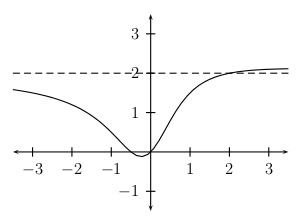Exercise 2.6.5
\[ f(x)=\frac{x(2x+1)}{x^2+1}=2+\frac{x-2}{x^2+1}\]
Since the denominator has no zeros, there are no vertical asymptotes. The quotient is \(2\) and the remainder is \(x-2\), so the graph has a horizontal asymptote \(y=2\) and the graph crosses the horizontal asymptote at \(x=2\) [since \(2\) is a transitive zero of the remainder]. The graph has two \(x\)-intercepts at \((0,0)\) and \(\left(-\frac{1}{2},0\right)\), both of which are transitive. The ratio of the leading coefficients is positive, so the graph lies above the \(x\)-axis on the interval \(0,\infty)\). The graph crosses the horizontal asymptote at \((2,2)\) and then approaches the horizontal asymptote from above. The graph dips below the \(x\)-axis on the interval \(\left(-\frac{1}{2},0\right)\), but lies above the \(x\)-axis and below the horizontal asymptote on the interval \(\left(-\infty,-\frac{1}{2}\right)\).
